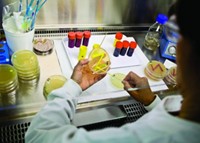Advertisement
Grab your lab coat. Let's get started
Welcome!
Welcome!
Create an account below to get 6 C&EN articles per month, receive newsletters and more - all free.
It seems this is your first time logging in online. Please enter the following information to continue.
As an ACS member you automatically get access to this site. All we need is few more details to create your reading experience.
Not you? Sign in with a different account.
Not you? Sign in with a different account.
ERROR 1
ERROR 1
ERROR 2
ERROR 2
ERROR 2
ERROR 2
ERROR 2
Password and Confirm password must match.
If you have an ACS member number, please enter it here so we can link this account to your membership. (optional)
ERROR 2
ACS values your privacy. By submitting your information, you are gaining access to C&EN and subscribing to our weekly newsletter. We use the information you provide to make your reading experience better, and we will never sell your data to third party members.
Business
Stretching Paint Performance
Functional additives push water-based paint into applications that were once unheard of
by Marc S. Reisch
June 6, 2011
| A version of this story appeared in
Volume 89, Issue 23

Waterborne paints are easy to apply, are easy to clean up, and have a reputation for being more environmentally friendly than the solvent-borne paints that are still considered the performance standard. But a host of new additives coming onto the market promise to extend the performance of water-based paints in ways that may make them equal to, or even better than, the competition.
Water-thinned coatings now make up one-quarter of the nearly $100 billion global paint market, notes paint expert Phil Phillips, managing director of the Chemark Consulting Group. Other paint technologies also considered environmentally friendly include heat-fusible powder coating and coatings that cure nearly instantly when exposed to ultraviolet or electron-beam radiation.
But although powder and radiation-cured coatings have their place, nothing beats the ease of using a water-based paint. That is partly why Phillips predicts that the global waterborne paint market will grow at a compound annual rate of 5.0% from 2010 through 2015. By contrast, the overall market, including solvent-borne coatings, will grow at just 3.2% annually, from $100 billion in 2010 to $116 billion by 2015.
Much of the historic improvement in waterborne paint quality was due to advances in resin-binder systems. But Phillips sees additives now on the cusp of commercialization as bringing a new set of improvements to waterborne paints. Some additives will provide special performance-enhancing attributes while others will boost waterborne paints’ already good environmental profile.
Byk, a firm owned by Germany’s Altana Group, develops additives for coating systems. Many of them do what additives have long done, such as help disperse particles in paint or help orient pigments as paint dries. However, over the past five years, the firm has set its sights on nanometer-sized additives to give paint properties that resins alone can’t provide.
This year, Byk expects to generate $1.5 million from sales of the nano additives, according to Robert H. McMullin, manager of new business development. The particles are so small, some measuring just 10 nm, they are impossible to see. “I’m selling the emperor’s new clothes,” he jokes.
But although they can’t be seen, the particles can, for instance, provide protection from corrosion and UV light. As an example, the firm’s Nanobyk line includes aluminum, silica, and silica/zinc particles that offer corrosion protection, McMullin says. They are intended to replace heavy-metal-containing primers, most of which are solvent-borne.
Regulators want to reduce the use of heavy metals, but in some critical applications, such as aircraft coatings, finding a less toxic substitute is problematic. Byk is working with customers now to test the Nanobyk particles in waterborne coatings that could replace solvent-borne chromate primers used on aircraft.
Particles made of zinc or cerium can be used in clear water-based overprint varnishes for outdoor signs, McMullin notes. They absorb UV light, just as minerals in sunscreens do to protect people from sunburn. But in the case of the sign, the particles prevent premature fading, he says, and they do it better than the hindered-amine light stabilizers now used to protect signs.
Byk is also developing a nanoparticle that allows scratches in a coating to heal themselves under ambient-temperature conditions. McMullin won’t be more specific about the particle itself because Byk hasn’t completed a patent on it yet. But if such a particle could make ambient-temperature, self-healing coatings a reality, they could be a real boon in highly demanding applications such as bridge maintenance and aircraft paints, he says.
Other additives aren’t novel because of their size, but because they are biobased ingredients that are bioactive in paint. Reactive Surfaces, based in Austin, Texas, has developed a number of fermentation-derived molecules, some of which can kill harmful bacteria and viruses on hospital surfaces or gobble up grease on a kitchen wall.
“People often think of paints as products that protect and decorate, but we think there ought to be a third criterion,” says Steve McDaniel, chief innovation officer of Reactive Surfaces, referring to bioactivity. For instance, incorporating the firm’s DeGreez additive into an acrylic latex paint can make greasy kitchen walls self-cleaning. The key in this case is a lipase enzyme developed by the 14-employee company.
Lipases are already widely used to degrease kitchen drainpipes. “We turned it into a paint additive,” McDaniel says. The enzyme remains stable in coatings for “a long period of time” even after scrubbing, he says.
An additive that Reactive Surfaces calls an environmentally friendly biocide is now undergoing final testing for Environmental Protection Agency registration. The seven-amino-acid peptide, called ProteCoat, kills bacteria, fungi, and viruses. However, McDaniel says, because it is not hazardous to people and animals “no precautionary labeling will likely be required” on paint that contains the biocide.
The peptide was developed as a pharmaceutical, but the drug was never approved, McDaniel says. His company bought the peptide and adapted it as an additive for paint and building materials such as wallboard, laminate, and cabinetry. Once it is registered with EPA, it is “destined for hospital surfaces where it can help stave off hospital-acquired infections,” he says.
Biocides are more typically added to paint to protect the paint film itself. McDaniel says the peptide has been tested in stucco paints, where it is effective against algae growth. ProteCoat will work in a variety of paint systems, he says, “but we are aware that a lot of the innovation in paint goes to waterborne systems, and so we are focusing on them.”
The problem with many traditional chemical biocides in paint is that they can pose an environmental hazard. International Specialty Products has taken a traditional biocide, 3-iodo-2-propynyl butylcarbamate (IPBC), and put it into a delayed-release microencapsulation system.
Speaking earlier this year at the Waterborne Symposium in New Orleans, sponsored by the University of Southern Mississippi, ISP Senior Scientist Raman Premachandran said the company is using a “natural” carrier as the encapsulant. Although he wouldn’t be more specific, he did reveal that encapsulants the company considered included a variety of clays, zeolites, and silicas.
While ISP is working to make traditional biocides safer to use, Cabot is promoting an additive that makes workers safer in industrial environments. Cabot initially developed its aerogel particles as insulation for subsea oil and gas lines and translucent skylights. In March, at the European Coatings Show, the firm launched Enova thermal insulation aerogel as an additive for paints.
Each aerogel particle is more than 90% air trapped in a network of amorphous silica, making it twice as insulating as dead air space, the company says. A coating system fortified with the aerogel particles and applied at just a few millimeters thick to a pipe heated to 200 °C is enough to protect any worker who touches it from a serious burn. A worker might touch such a pipe for five seconds and suffer no harm, says James Pidhurney, specialty chemical segment manager for Cabot.
Some industrial facility operators are reluctant to cover pipes with insulation such as mineral wool because they fear not being able to see and correct corrosion before it becomes a serious problem, Pidhurney notes. But a coating with the aerogel additive would immediately blister in the presence of corrosion, he says.
Additives such as Cabot’s are meant to be utilitarian; others are meant to improve the environmental qualities of paint. Eastman Chemical introduced such an additive, called Solus 3050, at the European Coatings Show. The cellulose-based ester for automotive and industrial paints “gives waterborne paint a better carbon footprint,” says Deepanjan Bhattacharya, global transportation leader at the firm.
For starters, Solus 3050 is a biobased molecule, Bhattacharya explains. The additive also enables faster drying times and provides a smoother finish. When automakers paint cars, they typically pass them through an oven twice to speed the drying process. Eastman’s new additive makes it possible to eliminate one of the baking steps, thus reducing the overall energy consumed, he says. The faster drying time can also increase the number of cars that can be painted during a work shift.
Another additive meant to address environmental concerns is a new benzoate-based coalescing aid under development at Emerald Performance Materials, the former food ingredient and industrial specialties business of Lubrizol that is now owned by Sun Capital Partners. Coalescing aids help paint form a continuous film as it dries.
The trouble with coalescents is that they contribute to the volatile organic compounds emitted from paints as they dry. VOCs are precursors of lower atmospheric smog. Emerald has developed a low-VOC dibenzoate coalescent blend, called X-20, that contains only 3% VOCs by weight, says William D. Arendt, a research fellow. The industry standard, 2,2,4-trimethyl-1,3-pentanediol monoisobutyrate, entirely evaporates from the coating, he says.
Given its low VOC content, the dibenzoate blend can contribute less than 1 g of VOCs per liter of paint, Arendt says, making it easier for paint companies to meet VOC requirements. California regulations now limit many types of architectural paints to less than 100 g of VOCs per liter.
Emerald expects demand for the new product, once it is commercialized, to be robust. Shamsi Gravel, product manager, says the firm is adding technical staff, buying test equipment, and designing a technical center at its Kalama, Wash., site to help customers formulate with the new coalescent blend.
Until now, resin systems carried most of the weight in a paint system, notes Chemark’s Phillips. Additives help out here and there, mainly to solve appearance or application problems. But it won’t be long, he says, before these new functional additives will allow formulators to sell fewer “me-too” paints and more high-margin specialty paints.





Join the conversation
Contact the reporter
Submit a Letter to the Editor for publication
Engage with us on Twitter